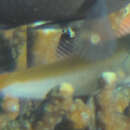Diagnostic Description
provided by Fishbase
Diagnosis: a black outer ring surrounding a bright yellow ring in iris of the eye; faint to bright white stripe originating on snout below ventro-anterior margin of orbit and continuing posteriorly along ventral margin of orbit to preopercular series of pores, ending or continuing much diminished in intensity to posterior margin of opercle; pale-margined, dark spot, smaller than pupil of eye, present on post-orbital margin at about 2 o'clock position. Body more or less uniformly olive-brown or with the indications of fine, greenish yellow, stripe-like area along dorsal body contour below dorsal fin, paralleled ventrally by broad, olive-brown area grading ventrally and narrowly to greenish yellow at body midline, then abruptly whitish below (Ref. 55736).
- Recorder
- Estelita Emily Capuli
Life Cycle
provided by Fishbase
Oviparous, distinct pairing (Ref. 205).
Trophic Strategy
provided by Fishbase
Found in clear coastal to outer reef habitats to about 20 m depth (Ref. 48636).
- Recorder
- Grace Tolentino Pablico
Biology
provided by Fishbase
Adults are found in clear coastal to outer reef habitats to about 20 m depth (Ref. 48636), perched on live corals in sheltered reefs (Ref. 90102). Oviparous. Eggs are demersal and adhesive (Ref. 205), and are attached to the substrate via a filamentous, adhesive pad or pedestal (Ref. 94114). Larvae are planktonic, often found in shallow, coastal waters (Ref. 94114).
- Recorder
- Cristina V. Garilao
Ecsenius ops: Brief Summary
provided by wikipedia EN
Ecsenius ops, known commonly as the eye-spot blenny or the yellow-eye combtooth-blenny in Indonesia, is a species of combtooth blenny the family Blenniidae.
It is found in the central Indo-Pacific area, specifically around Indonesia.
It can reach a maximum length of 5.5 centimetres.
Blennies in this species feed primarily off of plants, including benthic algae and weeds.
- license
- cc-by-sa-3.0
- copyright
- Wikipedia authors and editors

